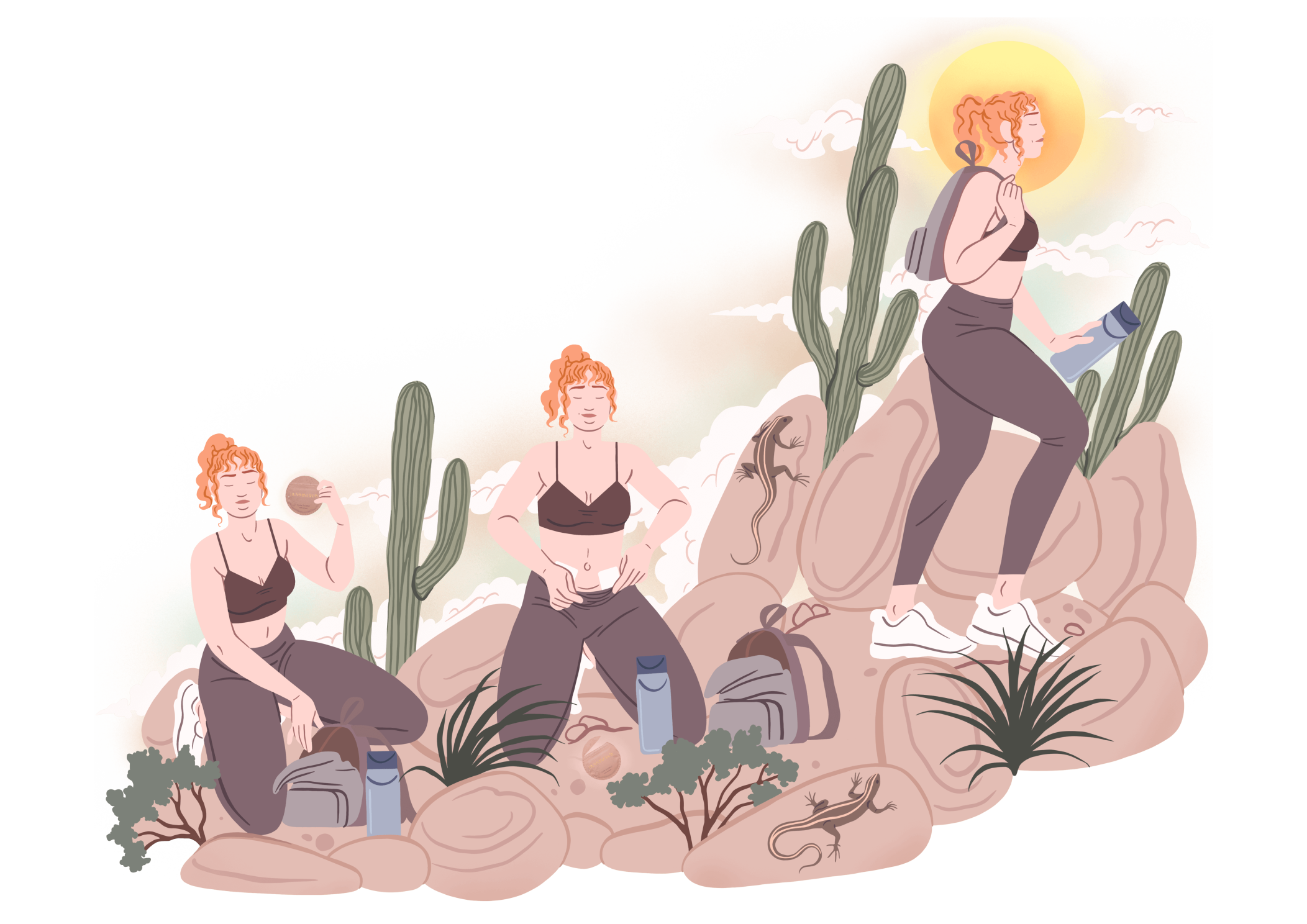PMDD and me - a personal story by Olivia Khoury
Hummingway co-founder Olivia Khoury shares how conversation, cycle mapping and considered approaches to her lifestyle led her to put a finger on PMDD - and how it isn't the average PMS feeling we've been led to believe.
Put a finger down if you get anxious or irritable before your period. Put a finger down if you experience period pain. Put a finger down if you have mood swings at least once a month. Put a finger down if your doctor prescribed you birth control to “balance” your hormones. Put a finger down if you think you may have a menstrual disorder. And finally, put a finger down if you’re tired of not understanding your body. If you put more than one finger down, please keep reading.
This piece may or may not be a metaphor for TikTok being more useful than our typical resources around sex education, but I digress. Here’s my story of figuring out my menstrual disorder diagnosis. It wasn’t entirely through TikTok - at least not entirely - but it does point to a collective effort to demand more from our typical seats of medical power and educational resources.


PMDD & Me
Premenstrual Dysphoric Disorder — or PMDD. Ever heard of it? I didn’t until I was diagnosed three years ago. For most of my menstruating life, I thought feeling “crazy” or “angry” or “emotional" were things I was supposed to feel before my period. It wasn’t just society supporting this message - my doctors said that my premenstrual experiences were typical “PMS” and I was just “hormonal”. It was very confusing when one week I’d be completely content with my life, and the next I’d be consumed by anxiety, depression, fatigue, anger, aggression, irritability, bloating, really really sore boobs, extreme body dysmorphia, and appetite changes that would recur like clockwork during the two weeks prior to my period. I now know these two weeks are known as the luteal phase.
Read The Zoom In: Luteal Phase
Every time I went to the doctor, my feelings were brushed off and I was told the only solution was contraceptive birth control. “Birth control will balance your hormones and make it all go away,” the doctor would say. Sound familiar?
If contraceptive birth control works for you, that’s amazing - especially for my friends out there with endometriosis. The plot twist, however, is that birth control does not "balance" your hormones. It simply turns them off. So that means no ovulation, and as a result, no cycling of reproductive hormones. The so-called “period” you experience on the pill is actually what’s called a 'withdrawal bleed'. It happens when the hormones in your pills drop and it’s not the same as a natural menstruation.
Fortunately, I have a mom in the know about birth control, so when the doctor said I’m just hormonal and the pill will help, my standing question remained: Why is this happening to me? What is the root cause of the pain? The extreme feelings? This can’t just be part of having a uterus. I called bullshit.
What is PMDD?
PMDD is a condition of severe premenstrual depression, irritability and anxiety - think “PMS" on steroids. It affects about 5-8% of menstruating people. That’s more than 6 million of us!
What causes PMDD?
There was a misconception that PMDD was caused by a hormonal imbalance, but in 2017, Dr. Peter Schmidt at the National Institutes of Health (NIH) found that people with this condition have an altered gene complex that “processes the body’s response to hormones and stressors in a different way than others.”
Generally speaking if you have PMDD, you have an increased sensitivity to your reproductive hormones two weeks prior to the start of your period.
“For the first time, we now have cellular evidence of abnormal signaling in cells derived from people with PMDD, and a plausible biological cause for their abnormal behavioral sensitivity to estrogen and progesterone.” says Schmidt. “This is a big moment for women’s health, because it establishes that women[people] with PMDD have an intrinsic difference in their molecular apparatus for response to sex hormones – not just emotional behaviors they should be able to voluntarily control,” said David Goldman, a colleague of Dr Peter Schmidt.
Source: National Institutes of Health
How to get diagnosed?
After my life-saving therapist brought PMDD to my attention, I began to track my cycle (the CLUE app and a good old-fashioned journal are my recommendations). Within the first three months it became very obvious that there was direct correlation between my period and my mental health. This diagnosis still isn’t very well known, it wasn’t until 2019 that the World Health Organization (WHO) validated the condition as a global health concern. (Source: IAMPD)
It was a great win, but don't be surprised if your doctor still doesn't know about it or isn’t taking you seriously. Add to that, if you're trans or non-binary you can still have PMDD, and it may even increase your feelings of discomfort with the gender you were assigned at birth.
It’s also possible to be wrongly diagnosed with other mental health conditions such as bi-polarity or Borderline personality disorder (BPD) simply because we share some of the same symptoms. The big difference is that PMDD symptoms will follow a regular pattern each month. So, again, if you notice a recurring pattern during your cycle, this may be a key indicator.
What can I do during each phase of my cycle to manage my PMDD?
Everyone's PMDD shows up in different ways, so everyone’s ways of managing and healing will vary.
While the awareness of knowing that these emotional and physical symptoms were temporary, from month to month, helped a lot, I still found myself on a mission to get to the bottom of it all. My big AHA! moment came while I was watching biologist Alisa Vitti’s TED Talk about cycle syncing. Of course! Coming from a household of functional medicine, it made sense to me that we can actually hack our cycle by mapping out when and how to exercise, eat, and even socialize strategically throughout the month to capitalize on the variety of hormone profiles. So that’s exactly what I did!
It made sense to me that we can actually hack our cycle by mapping out when and how to exercise, eat, and even socialize strategically throughout the month to capitalize on the variety of hormone profiles.
Menstruation
Do you feel sluggish and slow during the first few days of your period? I do! My hormones are at an all-time low so my mood matches that. I know, the initial reaction for a lot of us with low mood and energy is “where’s the caffeine?” We’ve been programmed by the patriarchy to get up and go. Marketed Midol all our lives, it was never told to us that it's okay to slow down during this time. It’s actually more beneficial for your body, specifically for those of us who are AFAB (Assigned Female At Birth), to put those HIIT workouts on pause and switch to more gentle movements like yoga and strength training.
Our metabolisms are moving faster during menstruation so we need more calories. I'm guilty of eating an entire chocolate cake on the first day of my period, so no judgement here, but definitely try swapping processed sugars for fruit or a dark chocolate bar. I can say firsthand that nourishing my body with complex carbs and healthy fats during my period versus leaning in to the processed snacks has had a huge impact on my mood.
Follicular Phase
After my period, during the follicular phase, estrogen levels rise and I'M THRIVING. This is when I’m making a lot of plans, completing creative projects, and doing a lot of dancing in the mirror. Even though I’m feeling my best during this part of my cycle, I try to avoid inflammatory foods, specifically dairy. A dairy-free diet and daily doses of B6 and magnesium are my natural histamine reducing strategies.
According to one of my period gurus, Lara Briden, "histamine and mast cell activation can play a role in PMDD. Mast cells are a type of immune cell that release prostaglandins, inflammatory cytokines and histamine. Histamine is an immune signaling protein that causes allergies and swelling. If histamine is the reason for your PMDD then you may experience anxiety around ovulation and right before your period, when histamine is the highest, breast/chest pain, migraines, reddish marks on skin after scratching, and period pain because histamine causes pain."
Ovulation
Right around ovulation, I have a very high sex drive but it’s confusing because I get this weird twinge on my left or right side that can last up to 24 hours. I use The Cycle Soother patch during ovulation, and I double down on my magnesium, taking 300mg in the morning and 300mg at night, which helps soothe anxiety and pain.
Read: The Zoom In: Ovulation to learn more about mid-cycle pain, it's an Actual Thing.

Luteal Phase
For people without PMDD, the increase in progesterone halfway through the luteal phase has an almost calming effect, but it's the opposite for those of us with PMDD. According to recent research by Dr. Tory Eisenlohr-Moul (another huge and much-needed leap in research, woohoo!), progesterone can be good for mood because it converts to a neurosteroid called allopregnanolone which calms Gaba receptors in the brain. However, for those with PMDD, allopregnanolone does not calm GABA receptors and can instead produce anxiety and intense mood symptoms.
Source: NCBI
My luteal phase typically lasts about 13 days. The irritability, crying, dark thoughts, frustration and anger often feel unmanageable. I like to run a warm CBD and Epsom Salt bath, and jot down feelings in my journal. And I try to swap caffeine for adaptogens. Adaptogens are non-toxic plants and fungi that help the body regulate stress. They literally adapt to what your body needs.
Here’s my smoothie recipe for calming the nervous system and fighting fatigue:
1 tsp of maca (boosts energy)
1 tsp of Ashwaganda (decreases cortisol)
1 tsp Cordyceps (reduces inflammation)
Any dairy-free milk
Bananas (high in magnesium)
Cinnamon (a known period pain soother)
Some yummy almond butter!
PMDD doesn’t just affect my mood. One of my biggest physical symptoms besides abdominal cramping is swollen breasts/chest, also known as fibrocystic breast disease. At Hummingway, we look at our menstrual cycle as a fifth vital sign. My sore boobs were indicating an iodine deficiency. I began taking 1000mcg of liquid molecular iodine in a little water daily and my boob pain eased! Kind of crazy… It’s not just me, check out this study clinically proving that iodine reduces the symptoms of fibrocystic breast disease.
Definitely check with your health care provider before you start taking molecular iodine as every body is different.
So the luteal phase is a big moment of discomfort for me, so there’s a lot of selfcare involved. This is the last (but certainly not least) remedy I recommend: ACUPUNCTURE! Not only does it work magic for the body and stress, but it's been clinically proven to reduce PMDD symptoms up to 50%. I try to go at least three times during my luteal phase. Acupuncture is often covered by insurance so ask around and find the right place for you.
Until Next Time...
While each of these discoveries have helped me manage my PMDD symptoms, there is one glaring fact that sometimes puts a damper on everything - the gender research gap is very real and apparent.
A lack of representation in clinical trials means a lack of data relating to our menstrual cycles. By sharing this very personal story, my hope is to inspire some of you out there to do the same and continue to raise awareness not only around PMDD, but also around menstrual and reproductive health as a whole.
We’re stronger together. So reach out, share your stories, and know that this community is a safe space for asking questions and seeking answers - always without judgement.
xo ,
Liv
In 2019, Olivia was diagnosed with Premenstrual Dysphoric Disorder (PMDD). In place of medication, Olivia looked to ways to manage the diagnosis holistically - through food, herbs, adaptogens, CBD, sleep hygiene, journaling, meditation and exercise.
As co-CEO and co-founder of Hummingway, Olivia oversees and leads everything from product development, marketing, packaging, manufacturing, website development, content platform, social media, and research.
Outside of work, Olivia enjoys growing her family of pothos, rescuing dogs and practising yoga. Olivia holds a Bachelor’s degree in Arts & Sciences from Rutgers University.


